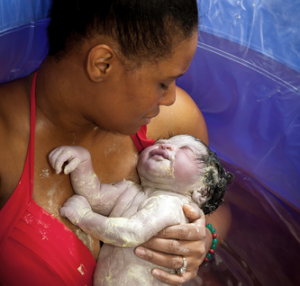A Baby’s 9 Instinctive Steps after Birth
The first hour after birth is a developmentally distinct time for the baby and the mother with well documented short and long term physical and psychological effects. It is one of the most significant transitions we make in life from an environment in water, weightless, cushioned – to an airborne environment with gravity as a major force.
Imagine the difference in experience this transition has when skin to skin on mom’s tummy feeling her warmth, breathing, heartbeat and voice or being handled under a hospital warmer.
 If we allow this first skin to skin contact we can observe nine newborn stages with specific actions happening in a specific order; they are innate and instinctive for the baby. This first skin-to-skin contact should happen immediately, without a delay for any routine procedures. If the mother has had analgesia/anesthesia during labor, it may take more time with skin to skin for the baby to complete the stages and begin suckling – the reflexes may be dampened, but they are still there!
If we allow this first skin to skin contact we can observe nine newborn stages with specific actions happening in a specific order; they are innate and instinctive for the baby. This first skin-to-skin contact should happen immediately, without a delay for any routine procedures. If the mother has had analgesia/anesthesia during labor, it may take more time with skin to skin for the baby to complete the stages and begin suckling – the reflexes may be dampened, but they are still there!
All these initial reflexes stay intact for the first 28 days! So this initial skin to skin contact can/should be repeated often.
Stage 1: The Birth Cry
This distinctive cry occurs immediately after birth as the baby’s lungs expand.
Stage 2: Relaxation
During the relaxation stage the newborn exhibits no mouth movements and the hands are relaxed while lying on mom’s tummy with a warm blanket. It’s the first time taking in gravity.
Stage 3: Awakening / approx. 3 minutes after birth.
The baby starts with small thrusts of movement in the head and shoulders and may open his/her eyes;
Stage 4: Activity / approx. 8 minutes after birth
The small movements grow – the rooting reflex becomes more obvious with increased mouthing and sucking movements; during this activity stage the newborn could:
- Keep his/her eyes open
- Look at his/her mother and look at the breast
- Salivate to the point of dampening the mother’s skin
- Root by moving his/her mouth from side to side over the skin by rubbing the cheek against the mother’s chests
- Move his/her hand to his/her mouth
- Move his/her hand to mother’s breast and back to his/her mouth
- Protrude the tongue
- Massage the breast with one or both hands
- Exhibit big rooting – includes shifting part of the baby’s torso from the mother’s chest
Stage 5: Rest
At any point the baby may rest between any of the activities above
Stage 6: Crawling / approx. 35 minutes after birth
The baby has a stepping reflex which enables him/her to move – crawl, slide or sometimes leap – towards the breast
Stage 7: Familiarization / approx. 45 min. after birth, lasting about 20 minutes
The baby may touch mother’s breast and mouth and his/her own hand, smell his/her hand, lick the mother’s breast, look at the mother, make soliciting sounds to get the mother’s attention, mouth the nipple, lick the nipple, move his/her hand from his/her mouth to the mother’s breast, protrude the tongue, and may also look at the other people in the room, (all this is raising the oxytocin levels in mom!);
Stage 8: Suckling / approx 1 hour after birth
Now the newborn takes the nipple, self attaches and suckles.
Stage 9: Sleep
The baby and often the mother too fall in a restful sleep for 1 to 2 hours.
Information based on Health Education Associates and the research of Ann-Marie Widstrom, Sweden
